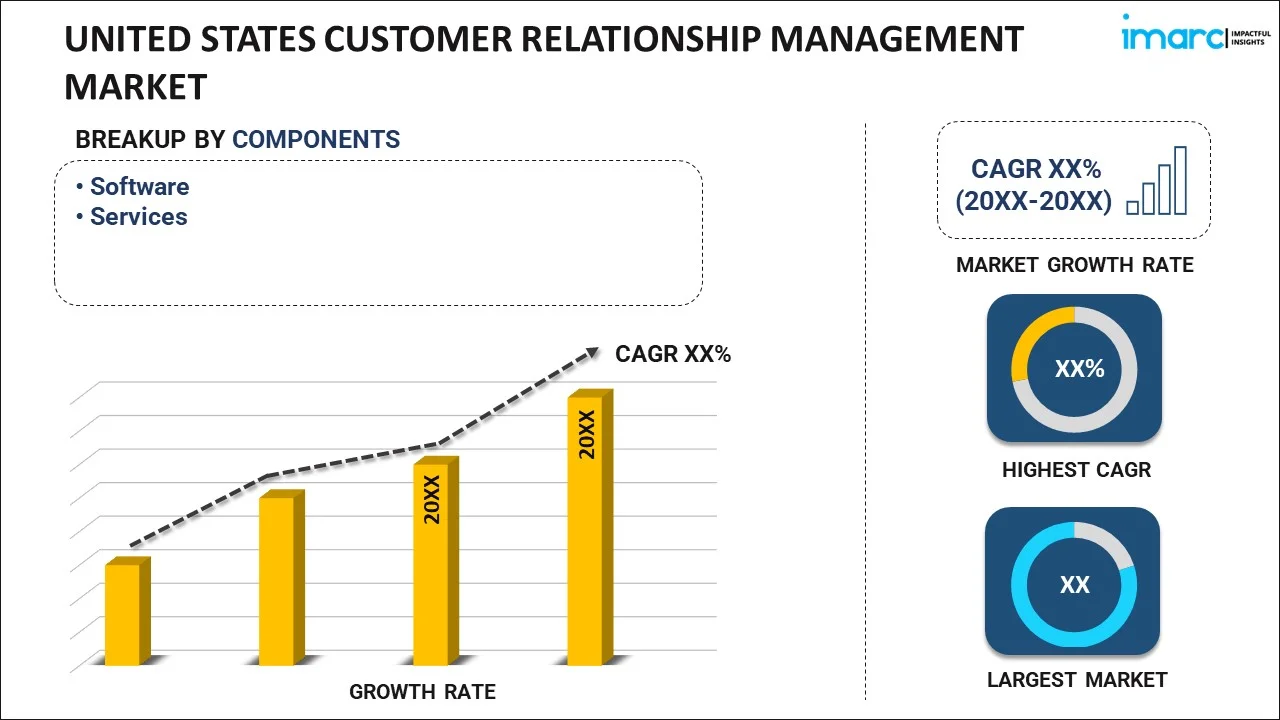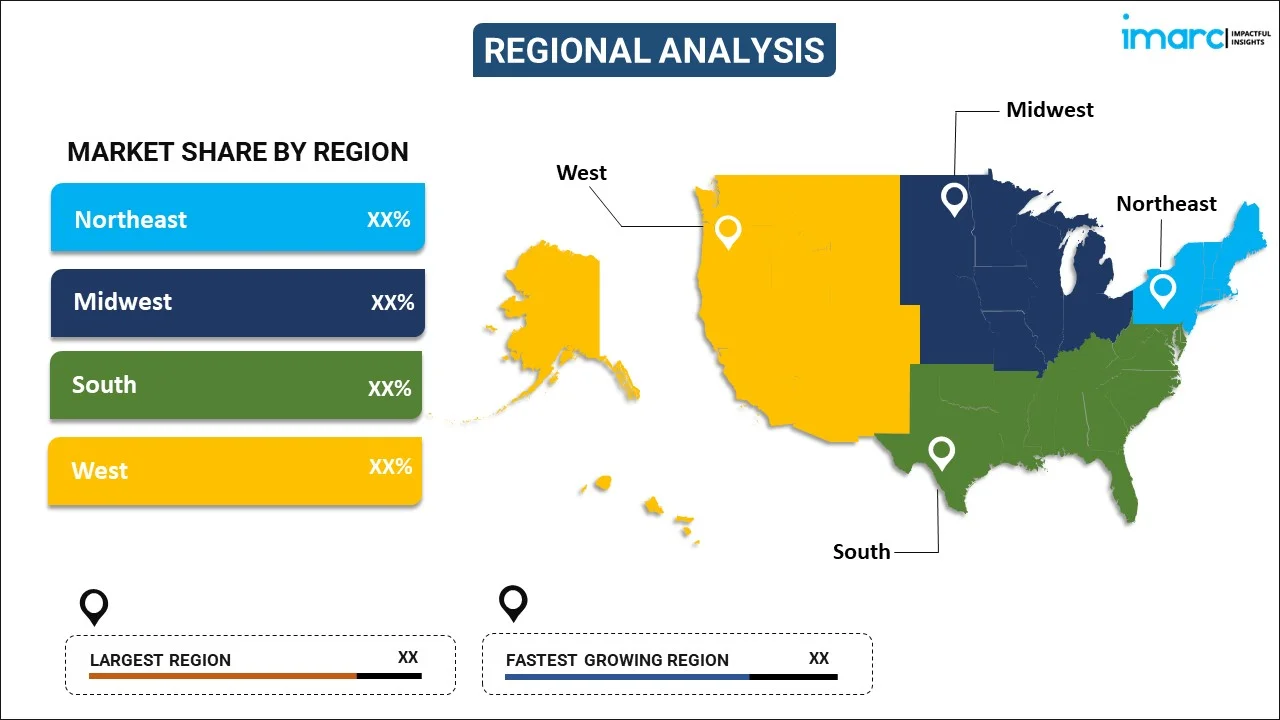
United States Customer Relationship Management Market Report by Component (Software, Services), Deployment Mode (On-premises, Cloud-based), Organization Size (Small and Medium-sized Enterprises, Large Enterprises), Application (Customer Service, Customer Experience Management, CRM Analytics, Marketing Automation, Salesforce Automation, and Others), Industry Vertical (BFSI, Retail, Healthcare, IT and Telecom, Discrete Manufacturing, Government and Education, and Others), and Region 2025-2033
Market Overview:
United States customer relationship management market size reached USD 17.4 Billion in 2024. Looking forward, IMARC Group expects the market to reach USD 35.5 Billion by 2033, exhibiting a growth rate (CAGR) of 8.27% during 2025-2033. The increasing amount of customer data being collected and stored, coupled with the growing emphasis on data security and privacy, is driving the market.
|
Report Attribute
|
Key Statistics
|
|---|---|
|
Base Year
|
2024 |
|
Forecast Years
|
2025-2033
|
|
Historical Years
|
2019-2024
|
| Market Size in 2024 | USD 17.4 Billion |
| Market Forecast in 2033 | USD 35.5 Billion |
| Market Growth Rate (2025-2033) | 8.27% |
Customer relationship management (CRM) is a strategic approach that businesses employ to manage and enhance their interactions with customers. It involves the use of technology and processes to analyze customer data and create a comprehensive view of each customer. CRM systems help organizations streamline sales, marketing, and customer service activities, allowing for more personalized and targeted engagement. By centralizing customer information, businesses can identify opportunities for growth, improve customer satisfaction, and foster long-term loyalty. Effective CRM systems enable businesses to understand customer needs, anticipate preferences, and tailor their offerings accordingly. Ultimately, CRM is a pivotal tool in building strong, enduring relationships with customers, driving customer retention, and maximizing overall business success.
United States Customer Relationship Management Market Trends:
The customer relationship management market in the United States is pivotal in shaping the landscape of modern business strategies. Firstly, the growing emphasis on data-driven decision-making is propelling the CRM market forward. Organizations recognize the importance of harnessing customer data to gain actionable insights and enhance customer interactions. Additionally, the increasing prevalence of cloud-based solutions is a key driver as businesses seek flexible and scalable CRM systems that can adapt to their evolving needs. Moreover, the rise of artificial intelligence (AI) and machine learning (ML) is revolutionizing CRM by automating routine tasks, predicting customer behaviors, and personalizing interactions. This technological evolution enhances efficiency, allowing companies to focus on meaningful customer engagement. Furthermore, the intensifying competition in the regional market is urging businesses to prioritize customer satisfaction and loyalty. As a result, CRM solutions become instrumental in building and maintaining strong customer relationships, ultimately driving revenue growth. In conclusion, the CRM market in the United States is being driven by a convergence of factors, including the demand for data-driven insights, the adoption of cloud-based solutions, the integration of AI and ML, and the imperative for businesses to remain competitive through enhanced customer relationships.
United States Customer Relationship Management Market Segmentation:
IMARC Group provides an analysis of the key trends in each segment of the market, along with forecasts at the country level for 2025-2033. Our report has categorized the market based on component, deployment mode, organization size, application, and industry vertical.
Component Insights:

- Software
- Services
The report has provided a detailed breakup and analysis of the market based on the component. This includes software and services.
Deployment Mode Insights:
- On-premises
- Cloud-based
A detailed breakup and analysis of the market based on the deployment mode have also been provided in the report. This includes on-premises and cloud-based.
Organization Size Insights:
- Small and Medium-sized Enterprises
- Large Enterprises
The report has provided a detailed breakup and analysis of the market based on the organization size. This includes small and medium-sized enterprises and large enterprises.
Application Insights:
- Customer Service
- Customer Experience Management
- CRM Analytics
- Marketing Automation
- Salesforce Automation
- Others
A detailed breakup and analysis of the market based on the application have also been provided in the report. This includes customer service, customer experience management, CRM analytics, marketing automation, salesforce automation, and others.
Industry Vertical Insights:
- BFSI
- Retail
- Healthcare
- IT and Telecom
- Discrete Manufacturing
- Government and Education
- Others
The report has provided a detailed breakup and analysis of the market based on the industry vertical. This includes BFSI, retail, healthcare, IT and telecom, discrete manufacturing, government and education, and others.
Regional Insights:

- Northeast
- Midwest
- South
- West
The report has also provided a comprehensive analysis of all the major regional markets, which include Northeast, Midwest, South, and West.
Competitive Landscape:
The market research report has also provided a comprehensive analysis of the competitive landscape. Competitive analysis such as market structure, key player positioning, top winning strategies, competitive dashboard, and company evaluation quadrant has been covered in the report. Also, detailed profiles of all major companies have been provided.
United States Customer Relationship Management Market Report Coverage:
| Report Features | Details |
|---|---|
| Base Year of the Analysis | 2024 |
| Historical Period | 2019-2024 |
| Forecast Period | 2025-2033 |
| Units | Billion USD |
| Scope of the Report | Exploration of Historical Trends and Market Outlook, Industry Catalysts and Challenges, Segment-Wise Historical and Future Market Assessment:
|
| Components Covered | Software, Services |
| Deployment Modes Covered | On-premises, Cloud-based |
| Organization Sizes Covered | Small and Medium-sized Enterprises, Large Enterprises |
| Applications Covered | Customer Service, Customer Experience Management, CRM Analytics, Marketing Automation, Salesforce Automation, Others |
| Industry Verticals Covered | BFSI, Retail, Healthcare, IT and Telecom, Discrete Manufacturing, Government and Education, Others |
| Regions Covered | Northeast, Midwest, South, West |
| Customization Scope | 10% Free Customization |
| Post-Sale Analyst Support | 10-12 Weeks |
| Delivery Format | PDF and Excel through Email (We can also provide the editable version of the report in PPT/Word format on special request) |
Key Questions Answered in This Report:
- How has the United States customer relationship management market performed so far and how will it perform in the coming years?
- What is the breakup of the United States customer relationship management market on the basis of component?
- What is the breakup of the United States customer relationship management market on the basis of deployment mode?
- What is the breakup of the United States customer relationship management market on the basis of organization size?
- What is the breakup of the United States customer relationship management market on the basis of application?
- What is the breakup of the United States customer relationship management market on the basis of industry vertical?
- What are the various stages in the value chain of the United States customer relationship management market?
- What are the key driving factors and challenges in the United States customer relationship management?
- What is the structure of the United States customer relationship management market and who are the key players?
- What is the degree of competition in the United States customer relationship management market?
Key Benefits for Stakeholders:
- IMARC’s industry report offers a comprehensive quantitative analysis of various market segments, historical and current market trends, market forecasts, and dynamics of the United States customer relationship management market from 2019-2033.
- The research report provides the latest information on the market drivers, challenges, and opportunities in the United States customer relationship management market.
- Porter's five forces analysis assist stakeholders in assessing the impact of new entrants, competitive rivalry, supplier power, buyer power, and the threat of substitution. It helps stakeholders to analyze the level of competition within the United States customer relationship management industry and its attractiveness.
- Competitive landscape allows stakeholders to understand their competitive environment and provides an insight into the current positions of key players in the market.
Need more help?
- Speak to our experienced analysts for insights on the current market scenarios.
- Include additional segments and countries to customize the report as per your requirement.
- Gain an unparalleled competitive advantage in your domain by understanding how to utilize the report and positively impacting your operations and revenue.
- For further assistance, please connect with our analysts.
 Request Customization
Request Customization
 Speak to an Analyst
Speak to an Analyst
 Request Brochure
Request Brochure
 Inquire Before Buying
Inquire Before Buying




.webp)




.webp)












